|
|
JKYog
e-Magazine, Issue No. 74
|
|
|
|
Editor's Message
Dear Readers,
In
this edition of our monthly magazine, our theme is 'Every Activity is
for the Pleasure of God.' In the first article, we explore the
importance of dedicating every action of ours to God. Further, from
Maharajji's lecture, we will understand that we should abandon the
desire for material pleasures and liberation. We will also share with
you news updates and glimpses of recently concluded Swamiji's Gujarat
and Indore Tour, 2015-16. To help with hair loss, we
introduce you to some asans and pranayam. Finally, don't miss our BM
contributions, CKC winners announcement, and bhog recipe.
Best Wishes,
Editor's Desk
editor@jkyog.org 
|
|
|
|
जग सुख क्षणिक मना, हरि सुख भूमा अपना |
jaga sukha kṣhaṇika manā,
hari sukha bhoomā apanā
O mind! The pleasures of this world are fleeting whereas the infinite bliss of Shyamsundar is meant for us, the divine souls.
|
|
|
 |
 |
Every Activity is for the Pleasure of God
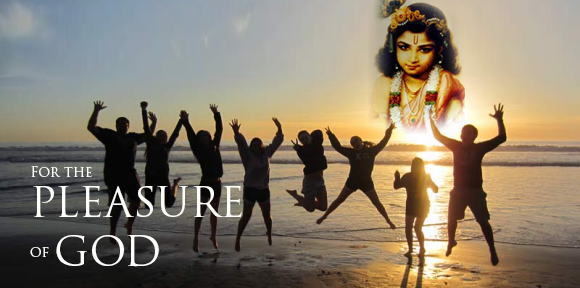 The
following article is an excerpt from Swamiji's lecture on Narad Bhakti
Darshan, a scripture brimming with the sweetness and bliss of devotion
in which Sage Narad reveals the knowledge of 'Bhakti.' The
lecture videos are also available on YouTube. To watch, visit: https://goo.gl/CpFZKg The
following article is an excerpt from Swamiji's lecture on Narad Bhakti
Darshan, a scripture brimming with the sweetness and bliss of devotion
in which Sage Narad reveals the knowledge of 'Bhakti.' The
lecture videos are also available on YouTube. To watch, visit: https://goo.gl/CpFZKg Many
a time, people have the concept that spirituality is something that
you do in the temple for half an hour, and that it has got no relevance
to their daily life. So, they will do puja in the temple for half an
hour, and when they come out, they start shouting at everybody! Their
thinking is, "That's OK, I can do that because I'm now outside the
temple, so I can do as I please!" Their thinking in this manner
is not the actual concept of true spirituality! Spirituality should be
reflected in everything that we do and it involves changing our
complete life! That is what Shree Krishna has asked us to do! yad karoshya dashnasi, yad juvoseeta dasyaha,
yad tapasyasi kaunteya, tad purushvama dharpanam
Shree Krishna in the Bhagavad Gita tells Arjuna, "Arjun, whatever you do, you must do it as an offering unto me!" Let
us say that when you have to eat, how is it possible to eat in the
spirit of offering? It is simple! Offer the food to Shree Krishna, and
request Him to eat the food first, and then after that you eat the food
as His remnants, as His Prasad! Or else, another way of doing it will
be, you think this way - "In order to Love and serve Shree Krishna, I
have to make sure that my body remains healthy, and therefore I have to
eat what is good for the body! Eat in that spirit!" In this mindset, you are eating only for the pleasure of God! Similarly,
when you are going to sleep, don't sleep thinking, "Oh how joyful
sleeping is!" Offer even your sleep to God, thinking, "Well, let me have
a good night's sleep so I will wake up fresh early in the morning, and
then I will be able to do my bhakti in the form of sadhana and seva. If I don't sleep well, then tomorrow morning my devotion will be disturbed!" Or else, think this way, "O Shree Krishna, I am going to sleep now. Please come in my dream and give me your darshan." Thinking in this manner when going to sleep, you have connected God with that activity. Shree
Kripaluji Maharaj says that even when you have to scratch your body
due to itchiness, don't scratch for your pleasure. Bring God even into
that by just thinking, Shree Krishna is standing there, he is laughing
at me, and you think, "Alright, My Lord, you continue laughing, I will
keep scratching for your pleasure!" In other words, somehow or other we have connected God to our every activity. Swami Vivekananda had said, "No work is secular! All work is devotion and worship!" No
work is Secular - You see, the Bhagavad Gita does not say, "Give up
your profession!" So, whatever profession you are in, you just keep
doing it, but change the consciousness - start doing it for the pleasure
of God! For example, if one is a businessman, it is in his nature to do business, his gunas
actually determine the profession that he is comfortable in. Someone
else could be comfortable in the financial management of an
organization. If we tell this finance manager, "Alright now! Please
take sannyas! Renounce everything and go and live in the
ashram, chant 'Radhey Radhey' and do spiritual service all day long!"
He will feel that this will be the worst kind of torture for him! So, Shree Krishna says, "You keep working in accordance with your gunas, however, you must offer the results of that work to God!" So,
if one is a businessman, there is no harm in making profit, but it is
important that the person thinks in this spirit, "After using the money
for whatever my basic necessities are, I will serve God with the rest
of my earnings!" Historically, there have been numerous great
Kings, who ruled over their kingdom, but they ruled in this spirit, "Let
me rule my kingdom in such a manner, that all my subjects get an equal
opportunity to perfect their lives in attaining their Love for God!" Similarly,
if you have children, you should cultivate desire to help them make
their lives perfect, bearing in mind that "They are not my children,
they are actually God's children' but I have been given the
responsibility of taking care of them in this life. Therefore, it is my
duty to also give them the opportunity to make their lives perfect!" The
test, however, is whether you are doing your duty as a parent for
God's pleasure or for your own pleasure! The real test is, if the
result is not according to what you think should happen, you do not
feel disturbed or disappointed by it! If you do feel disturbed, then it
is proof that you are doing it for yourself! If you are doing it for
God, then there is no disturbance. You should think, "I have put in my
best effort, and this is the result - so I will accept it as God's wish
for it to be so! I leave it to Him!"There are two kinds of worlds -
the inner world and the external world. The external world as we all
know is made of earth, water, fire, air, and space; it is the
combination of these five gross elements and the other subtle
elements. However, there is an internal world as well.
|
 |
Abandon the Desire for Material Pleasures and Liberation
There are three entities in existence:
Individual soul, God and Maya. We are individual
souls. We are ignorant; we suffer
from sorrows and are dissatisfied. God
is Blissful, omniscient, and complete. Maya is
the third entity; it
is devoid of life and
consciousness. The world has been created
for the sake of the physical body.
The individual being has a choice.
It can worship either God or the
world.If we worship the world, it
is called bhukti (indulging in material pleasures). If we worship God, it is called bhakti
(devotion). The third possibility is for
the individual soul to merge into Brahman, and this is called mukti
(liberation). That's it. There is no
other choice. Besides the individual soul,
there is God and there is 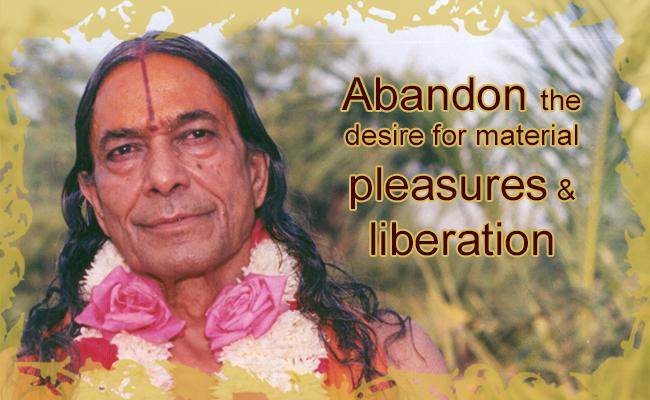 Maya. By going towards God one can attain either mukti (liberation) or bhakti (devotion). By going towards the world we can attain only one aim, and that is bhukti. What does the word bhukti mean? In simple terms, bhukti
means material pleasures of the physical body. We possess five organs
of perception: eyes, ears, nose, tongue, and skin. Related to these five
senses of perception there are five
desires: to see, hear, smell, taste,
and touch. We can never have a
sixth desire. Our body is made of the five
gross elements, and as such the five sense objects are made of the five
elements. The world is also made of the same five elements:
ether, air, fire, water, and earth.
The object of the five senses is
the world in its totality. The
pleasures of the sense-objects are
collectively known as bhukti. In bhukti
there is no concern whatsoever with
the soul. There are only two;
the enjoyer and the enjoyed. The
ignorant ones, who accept themselves
to be the body, run after sense
pleasures. The happiness in the celestial
abodes is millions times greater than worldly happiness, but
it also has no concern with the soul. It is also classified
as bhukti.
This is what the Gita says: ābrahma bhuvanāllokaḥ
We
come to the world and leave from here; we come and go again and
again. The ones who are running
after bhukti have only three works to perform: punarapi jananaṁ punarapi maraṇaṁ punarapi jananī jaṭhare
hayanaṁiha sansāre khalu dustāre kṛipayā pāre pāhi murāre
They
take birth, they die, and then
they hang upside down in the womb of a
mother. Then they are reborn only to die again. All this
goes on because we have accepted ourselves to be the body. This is
the mistake we make. Instead of being situated in our true nature
as the eternal soul, we accept ourselves to be the body. All the pleasures of the senses, extending up to those found in Brahma-lok (the highest celestial abode) are collectively known as bhukti. And then there is mukti,
i.e., liberation. Liberation is a big thing. After
attaining liberation we are no longer subjected to the pain of worldly
suffering. We attain permanent relief from coming and going to and from
this world. Liberation means permanent release. When the
individual soul merges into Brahman, he attains permanent
relief from material misery and eternal happiness. Now, the
duality comes to an end and he becomes united with Brahman. There are three classes of bhukti (material enjoyment), and they all culminate in sorrow and suffering. The three classes are dharma (performing one's worldly duties), arth (accumulation of wealth) and kām (fulfillment of material desires). In liberation, however, one attains eternal happiness. Yet, the one who desires bhukti and the one who desires mukti are both foolish. Why foolish? Scriptures have called bhukti and mukti witches. The scriptures say: bhukti mukti spṛihā yāvat piśhāchi hṛidi vartate
tāvad bhakti sukhasyātra kathamabhyudayo bhavet
(Bhakti Rasamrit Sindhu)
Chaitanya Mahaprabhu says: agyāna tamera nāma kahiya kaitava
dharm, arth, kām, mokṣha, ādi sab
" Dharma (virtuous deeds), Arth (wealth), Kām (desire), and Moksh (liberation) are all very deceiving." tār madhye mokṣha vāñchhā kaitava pradhān
"And
out of these four, liberation is the most dangerous." What are
you saying? Liberation means freedom from the bondage of
Maya. Yes, that's true. But, liberation is of many kinds.
Those who seek ekatva mukti merge into the formless Brahman
aspect of God. So, they are deprived of the supreme bliss of divine
love, which requires remaining separate from God, and engaging in his
devotion. Those who attain liberation is forever deprived of the
devotional nectar. This is why they are unfortunate. Bhukti and mukti are both deceptions. Even amongst these two, mukti
is the greatest deception. This is why devotee saints have
criticized liberation. The reason is that as long as we are
absorbed in bhukti, we have a chance of meeting a saint, who
will tell us about devotion. Then if we obey the saint and practice
devotion to God, we can receive the nectar of devotion for eternity in
the abode of God. But, if we attain ekatva mukti, the liberation that gyanis strive for, we will merge forever into Brahman and never return to the material world. na sa punarāvartate, na sa punarāvartate
The
Vedas say that after attaining liberation, the individual soul no
longer returns to the world. So, we will remain merged with Brahman forever, and never have the chance of tasting the bliss of divine love.
|
 |
|
|
Banara Retreat and Jagadguruttam Divas Celebrations
Grand celebrations
were held in Banara, Odisha on the occasion of Jagadguruttam Divas. A
week long sadhana shibir (retreat) with more than a thousand devotees
was already underway in JKU and everybody was looking forward to the
celebrations. Swamiji performed Shree Maharajji's Abhishek and a special
Dawat was also organised.
As a part of the celebrations, devotees performed Maha Aarti for their beloved Spiritual Master. Click here for picture and videos of the retreat.
Swamiji's Gujarat Tour
Swami
Mukundananda as a part of his India tour spent 12 days travelling in
different parts of Gujarat. In a very short span of time he
visited Vapi, Baroda, Anand, Palanpur and Patan. Wherever Swamiji
arrived during his Gujarat tour, the devotees welcomed him with great
joy and eagerness.
This
time Swamiji conducted a week long Bhagavat Saptah in Patan. The
program began with a grand procession of the Srimad Bhagavatam. As
per the local traditions, devotees performed poojan of the 'Bhagavat
Puran Granth' and carried it with grand celebrations to the program
venue.
The
lecture series was then concluded with a return pothi yatra, where the
Shreemad Bhagavatam was taken back from the venue in a procession. As a
part of the Bhagavat Katha Saptha, Ram Janma Utsav, appearance of Lord
Krishna, and Giri Goverdan Utsav were celebrated with great joy and
enthusiasm.
Devotees
were sad that the joyous program had come to an end. Swamiji did an
extended program in Patan after a long gap of twelve years. In 2004, he
had conducted a twenty-four day program here and established the Radha
Krishna Satsang Mandal, which is continuing till today, and through
which dozens of devotees have transformed their lives.
Swamiji's Indore Tour
The
Management Marshals Group, Lions Club International and the Radha
Krishna Satsang Samiti, Indore jointly organized Swamiji's program at
the Pritam Lal Dua Hall. The participants were thrilled to learn the art
of working with spiritual consciousness, which was so vividly explained
by Swamiji. The discourse was followed by an enthusiastic session of
questions and answers. Swamiji's logical and crystal clear explanations
won the hearts of the audience, who clapped repeatedly to show their
appreciation for every point that was explained. Click hereto view more photos
|
|
|
 |
|
|
|
Feb 7th to 11th
|
Patel Nagar, Delhi
| |
Feb 12th
|
Ashok Vihar, Dehi
| |
Feb 13th to 19th
|
Vikas Puri, Delhi
| |
Feb 20th
|
Ghaziabad
|
|
|
Feb 26th to 28th
|
Vrindavan
| |
March 1st to 2nd
|
Jajpur, Odisha
| |
March 3rd
|
Dhenkanal, Odisha
| |
March 5th to 8th
|
Banara, Odisha
|
|
| |
For details, click here
|
|
Yoga to Prevent Hair Loss
|
|
|
|
Now
a days, hair problem is a common issue. Stress, hormonal disorders,
diseases, genetic problems, poor eating habits, nutritional
deficiencies, diseases are often the causes for hair loss. Doing yoga
and meditation to restrict hair-loss will not only give you healthy
hair, but also benefit your whole system. It will improve your all round
health physically and mentally also. Yoga will help enhance circulation
of blood in the scalp, improve digestion and reduce anxiety and stress
too. Here are some yoga poses that you can try at home to protect
your hair.
Sarvangasan (Shoulder Stand Pose)
Procedure:
Lie flat on your back with both your legs together and touch the
outer sides of the thighs with your palms, i.e. Simple Supine
Pose. While inhaling (Radhey), gently raise both
legs together. While exhaling (Krishna), taking support of the
arms and elbows, raise your lower back; ensure your legs remain
perpendicular to the ground at 90 degrees. Place your elbows
firmly on the ground and support the back with both hands. Now try
to lower your feet towards your head until the legs get parallel to the
floor; inhaling (Radhey), raise your back; then shift
your supportive hands to the middle spine to support the back; then
raise your legs and lower trunk vertically. As you exhale
(Krishna), make both-the trunk and legs-erect by stretching your back,
settling chin in the suprasternal hollow. In the final position,
the body-weight is on
the neck, head, and the arms. Stay effortlessly
for as long as possible with normal breathing. Gradually reverse the
order, and return to the initial phase. Eventually, come into Shavasan
and relax the whole body.
Contraindications:
People
with high blood pressure, glaucoma, hernia, cervical spondylitis,
slipped-disc, heart problems, weak eye vessels, impure blood,
thrombosis, kidney problems, active menstrual cycle, and pregnancy
should not include this asan in their exercise. Also, people suffering
from neck injuries should not do it without the counsel and guidelines
of a Yog expert.
Pada Hastasan (Hand to Foot Pose)
Procedure: To perform this yoga pose, stand straight. While exhaling (Krishna),
bend forward from your waist to touch the knees with the
forehead. Then, place your hands flat on the floor on either side
of your feet, locking the knees. If you cannot bend completely, or
are uncomfortable bend your knees a little. Stay in this pose till you
are comfortable. and slowly return back to the standing position.
Kapalbhati Pranayam
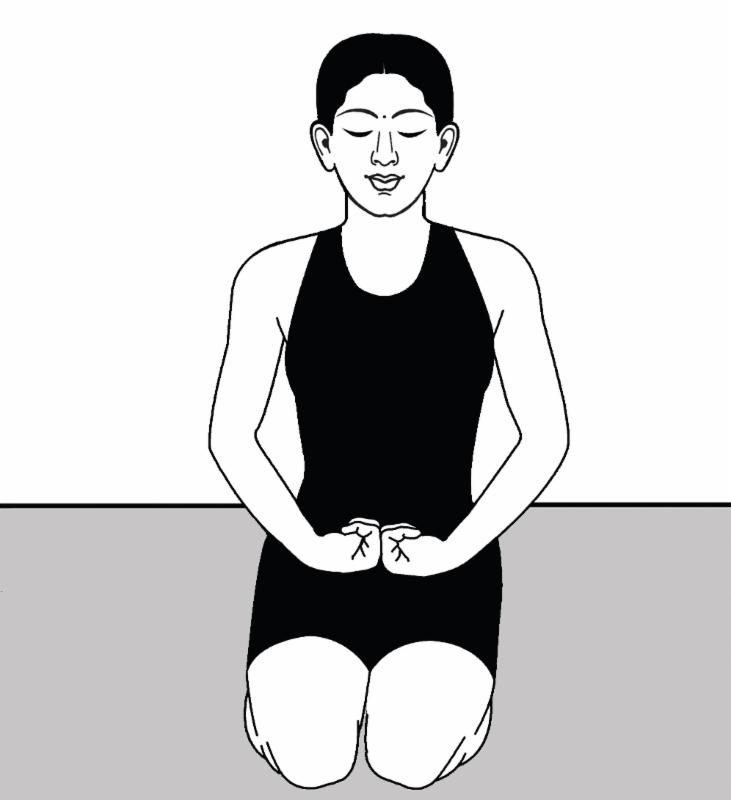
Kapalbhati
pranayam is most effective in Vajrasan. However, if you cannot
conveniently adopt that posture, you may sit in any other meditative
posture.
Procedure: Sit in any meditative
pose, with the spine and head erect. Relax your shoulders. Bring
your hands to Brahma Mudra, i.e. clench your fists and place them
side-by-side above the navel. The little finger side of the hands should
be toward the navel. The folded fingers of both hands should be
adjacent to each other. First inhale (Radhey) slowly and then exhale (Krishna)
forcefully by contracting your abdomen. Allow the abdominal
muscles to relax; thereby, the breath will naturally flow into the
lungs. In this pranayam, effort is not used for inhalation; it occurs
naturally.
Kapalbhati, it is important to note that the breathing
should be performed with the use of the stomach; there should not be
any use of the chest and the shoulders. While practicing this, one
should be aware of the contraction and especially, the relaxing
expansion of the abdominal muscles to allow the air in. This
completes one cycle; practice 60 cycles. This makes one chakra. In the
beginning you may get tired after 10 to 15 cycles. Over a few weeks, you
will be able to reach one chakra. With a regular practice, you
can go up to five chakras, with short breaks in between.
Timing:
The exhalation is done in 1/4th of a second. The inhalation is done in
3/4th of a second. So, one cycle of Kapalbhati Pranayam is
completed in one second. In this way, one chakra takes 60 seconds.
Beginners may find this strenuous. In that case, they may complete one
cycle of Kapalbhati in two or three seconds.
Contraindications:
People with high blood pressure, heart problems, spinal problems,
epilepsy, hernia, gastric ulcer, slipped-disc, and cervical spondylitis
should not do this pranayam. It is also prohibited during menstrual
periods and advanced stages of pregnancy.
|
|
|
JKYog Presents
Bal-Mukund
Personality Development Classes for Children
| |
|
|
Diwali Mela by Bal-Mukund NC Center
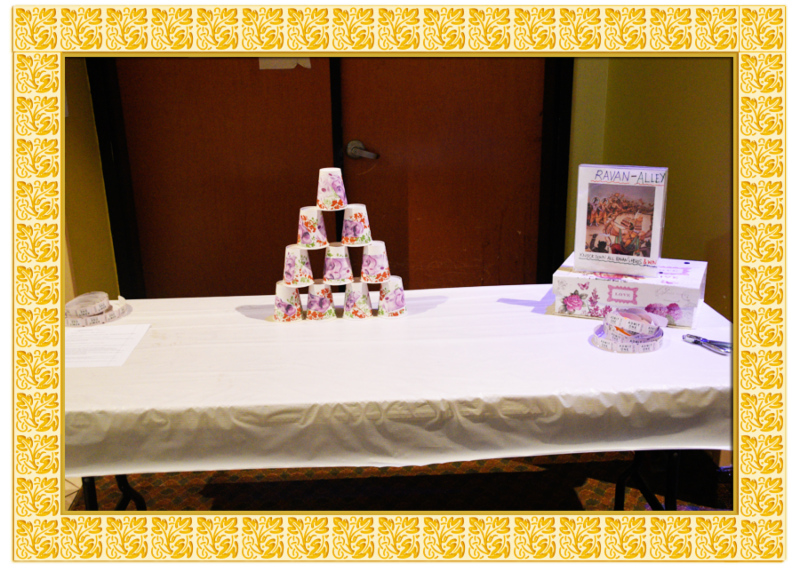 It was joyful seeing almost all 40 BM families on Saturday morning on Nov 14th to celebrate Diwali Mela in Bal-Mukund It was joyful seeing almost all 40 BM families on Saturday morning on Nov 14th to celebrate Diwali Mela in Bal-Mukund
NC!
All had an enjoyable mela. We had about 100 people attend this event
which was a nice rewarding experience for all volunteers. It was
such a delight to see not only our Bal-Mukunds enjoying the spread of
12 games & jeopardy but the parents having a blast solving puzzles , trying out some games and enjoying Bal-Mukunds play musical chairs ! We had 12+ Ramayan-theme based games , like Locating Hanuman's Gada with blind-fold, Ravan-Alley ,Ramayan wheel of 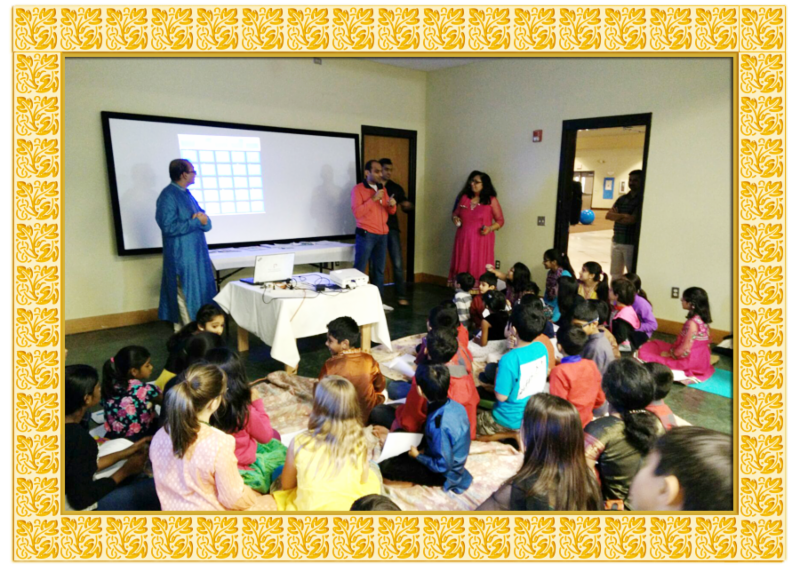 fortune,
Bhaiya Dhooj Car Race, Musical Chairs, Sack Race to the
Sun, etc going on simultaneously ! Balmukunds also enjoyed the Jeopardy game designed on questions from Balmukund syllabus categories like Yoga
Poses , Kripalu Values, Mahabharata, Gods, Dashavtar. There were also
stalls of Rangoli Paintings, Face paintings & Mehendi paitnings
too.We were delighted to recognize the efforts of our students with
Awards for 1) Winners of Jeopardy , 2) Lucky Raffle winners - 3) Game of
"Locating Hanuman's Gada " , 4) Ganesha Coloring Contest fortune,
Bhaiya Dhooj Car Race, Musical Chairs, Sack Race to the
Sun, etc going on simultaneously ! Balmukunds also enjoyed the Jeopardy game designed on questions from Balmukund syllabus categories like Yoga
Poses , Kripalu Values, Mahabharata, Gods, Dashavtar. There were also
stalls of Rangoli Paintings, Face paintings & Mehendi paitnings
too.We were delighted to recognize the efforts of our students with
Awards for 1) Winners of Jeopardy , 2) Lucky Raffle winners - 3) Game of
"Locating Hanuman's Gada " , 4) Ganesha Coloring Contest
Republic Day Celebration by Bal-Mukund CT children
The
atmosphere was pure enthusiasm, splashed with saffron, green and white!
Balloons, streamers and Bal Mukund Volunteers welcomed children in
fancy dress with their supportive families for the celebration of recent
learning.
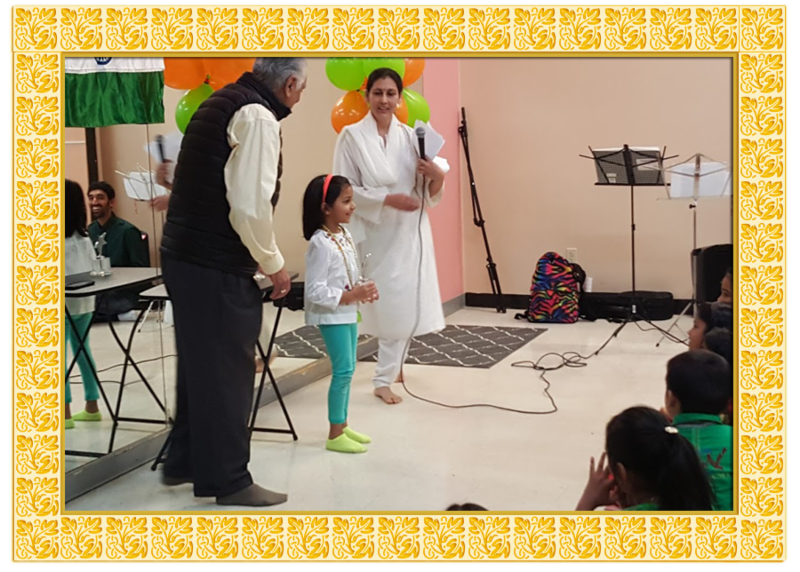
The
festival opened with Bal Mukund kids, seated in neat rows, calm and
focused, ready to delight all by demonstrating their knowledge and
presentation skills. Children took their well-practiced meditation poses
and began the program by chanting several shlokas, nicely "in sync,"
which brought everyone into reverence and focus. Next came the Hindi
language class groups who performed traditional songs with movements.
Then came fancy dress competition and presentations by individual
children grouped in three segments by age. The younger 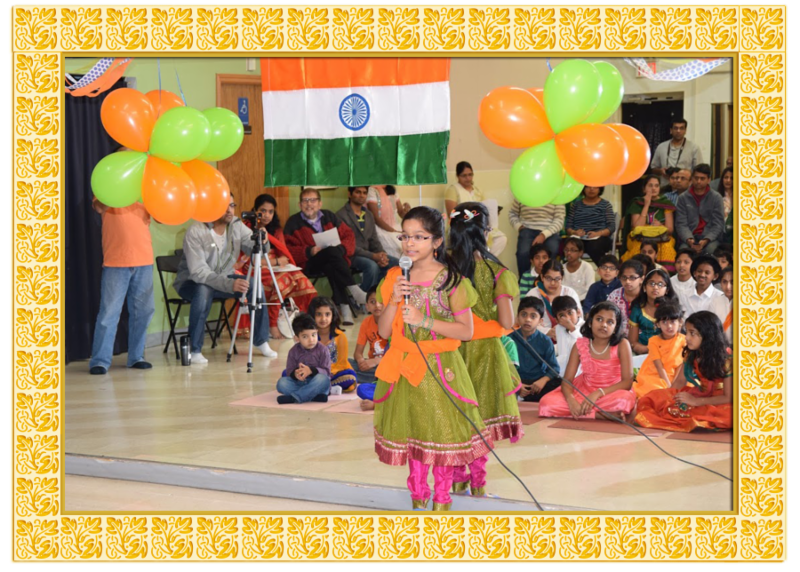 group chose to portray India's wealth of wise leaders. Dressed to
convince us of their 'identity', each speaker educated the audience and
recited famous lines (all memorized by heart!) Next came the segment of
older children, who had studied and prepared poster-reports about
'treasures' of India, such as geographic features, history and religious
sites. And finally, the eldest children presented posters and
speeches on topics related to 'India and the world' which they had also
researched. Prizes were awarded, and the and leader of the ,
chosen by audience "Popular Choice Vote!" In the 'grand finale' combined
Bal Mukund kids' patriotism, studies and musical talents, as they led
the National Anthem of India The entire group: Bal Mukund
children, volunteers and the large audience of families, sang in unity!
group chose to portray India's wealth of wise leaders. Dressed to
convince us of their 'identity', each speaker educated the audience and
recited famous lines (all memorized by heart!) Next came the segment of
older children, who had studied and prepared poster-reports about
'treasures' of India, such as geographic features, history and religious
sites. And finally, the eldest children presented posters and
speeches on topics related to 'India and the world' which they had also
researched. Prizes were awarded, and the and leader of the ,
chosen by audience "Popular Choice Vote!" In the 'grand finale' combined
Bal Mukund kids' patriotism, studies and musical talents, as they led
the National Anthem of India The entire group: Bal Mukund
children, volunteers and the large audience of families, sang in unity!
Swamiji's Birthday Celebration
Bal-Mukund
centers across the globe joined hands to wish Swamiji a wonderful
Birthday. All are thoroughly enjoying the sessions, be it the
students attending the Bal-Mukund class or the Volunteers teaching the
class. This is completely evident from their smiling and enthusiastic
faces. The parents and in fact the entire family are benefiting from
this beautifully program! They are thankful to Swamiji for designing
this great program and making it simple and easy to inculcate Vedic
values in the family.
Click here to see the video |
| |
|
|
|
|
 |
|
|
|
Group 8 - 11
|
1st Prize Winner
|
Ria Patel
| |
2nd Prize Winner
|
Rachana Tanksali
| |
3rd Prize Winner
|
Shyam Sivasubramaniam
| |
Group 12 - 15
|
1st Prize Winner
|
Saloni Agrawal
| |
2nd Prize Winner
|
Sonakshi Bhatia
| |
3rd Prize Winner
|
Ashlita Lodha
|
|
Cabbage and red pepper with flax seeds
|
|
|
Ingredients:
- Cabbage - half head, julienned
- Red bell pepper - 1, julienned
- Flax seed powder - 4 teaspoons
- Mustard seeds - 1 teaspoon
- Curry leaves - 6-7
- Dried red chilly - coarsely ground, 1/2 teaspoon
Asafoedita - 1/4 teaspoon - Urad & Chana dal mix - 1 tablespoon
|
|
Potential Health Benefits:
Cancer prevention, lower blood cholesterol, lower blood sugar, weight management, eye health.
.
|
 |
|
Contact us
|
The Editor JKYog: XVII/3305, 1st Floor, Ranjit Nagar
(Near PUSA), New Delhi - 110008, India
|
7405 Stoney Point Dr, Plano
TX 75025, USA
|
|
|
|
|
|